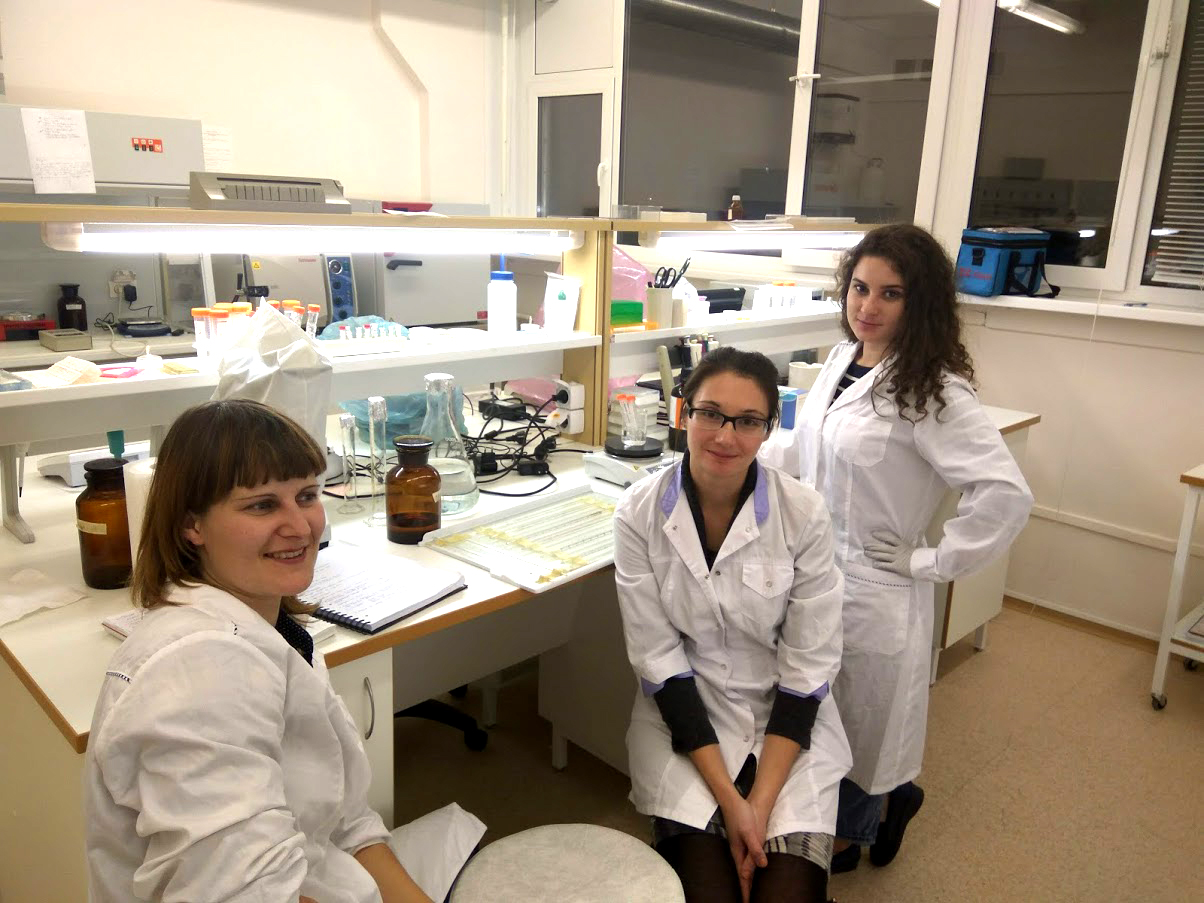First prize to radiobiological research
News, 29 January 2021
At the end of last year, results of the competition for JINR Prizes for young scientists and specialists in 2019-2020 were published. According to the results of the second stage held online, the first prize in the section “Scientific and research experimental papers” was awarded to R. A. Kozhina (LRB).
I work at the fluorescence microscopy group; we research the biological effects of ionizing radiation with different physical characteristics on various DNA damage formation and repair. DNA repair is a special cell function by which a cell corrects DNA damage and molecular lesions damaged during normal DNA biosynthesis in a cell or as a result of the action of physical or chemical agents.
 From left to right: Elizaveta Ilyina, Eugenia Kuzmina, Regina Kozhina
From left to right: Elizaveta Ilyina, Eugenia Kuzmina, Regina Kozhina
The hippocampal cells of rodents are the main object of our research, we mainly work with mice, in some experiments with rats. Hippocampus is a small part of the brain that plays a key role in short-term memory formation, its further transition into long-term one and in spatial navigation. Moreover, many studies have shown that the formation of new neurons (neurogenesis) occurs in the hippocampus throughout life, which is why this brain structure is more radiosensitive as compared to the other adult brain cells. Therefore, research of various DNA damage formation and repair processes in the hippocampus is extremely important.
The study of DNA damage formation and repair processes under ionizing radiation of different quality makes a great contribution to the understanding of fundamental biological systems operation. However, it should not go unmentioned the practical aims to the solution of which these studies can make a significant contribution. For example, planned long-term manned space flights as well as improvement of existing cancer treatment methods.
The most important thing for manned flights into outer space is the preservation of mental clarity, the ability to perform application tasks, ensuring the normal spacecraft operation and, on the top of that, the main research work performance. The constant effect of space radiation on the cells induces a wide spectrum of DNA damages, which can lead to both the malignant cell transformation and cell death, which can subsequently become one the reasons for changes in higher integrative functions of the central nervous system.
Our research is undoubtedly fundamental. The era of radiobiological space research began quite literally in space. Before the first manned space flight, researchers carried out experiments on living organisms, sending various model systems on satellites’ boards. It was difficult and sensational but, unfortunately, there were no statistics because the experiments were unique. There were problems with the results interpretation and their extrapolation; over time it became clear that it was necessary to start with experiments in earth conditions, carefully collecting statistics. It was necessary to study the fundamental mechanisms of biological processes first thus to understand how the same processes occur in outer space.
At the moment, we have provided a large number of experiments aimed at studying dose dependences of a wide spectrum of DNA damage formation: from single-strand breaks to clustered DNA damage in mammalian neuronal cells. The dependencies between the age of mice and the hippocampal cells radiosensitivity after exposure to gamma rays were studied. In addition, the comparative analysis of the DNA damage repair kinetics in vivo and in vitro was carried out. Furthermore, we have carried out a series of experiments to study the effect of modifying agents, such as monophosphoryl lipid A (MLA) and diphosphoryl lipid A (DLA). At the moment, the study of the DNA repair inhibitor 1-β-D-arabinofuranosylcytosine (AraC) effect in neuronal cells under ionizing radiation is one of our work focuses.
In the foreseeable future, we are going to continue our comprehensive research of the different DNA inhibitors effects on forming lesions in mammalian normal and tumour cells as well as start using a new method, Western blotting, which allows identifying specific repair proteins.
I am lucky to work in a warm and friendly atmosphere with hardworking people who are involved in the work process. Of course, good teamwork is only possible with competent distribution of tasks. Vladimir Nikolaevich Chausov is engaged in it in our group. Thanks to his professionalism, the ability to optimize strengths and responsibilities, we manage to do quite big experiments simultaneously. For example, Evgenia Kuzmina and I work with hippocampal cells, and Svetlana Tiunchik together with Elizaveta Ilyina work with cells of cerebellum. In our work we mainly use a fast and highly sensitive method, the comet assay. The use of this method under alkaline and neutral conditions allows us to detect DNA single- and double-strand breaks respectively. The entire team process the results, this accelerates the process and also makes it possible to collect statistics to obtain reliable results. During my short working period at the Institute, I was often surprised at how self-motivated and independent my colleagues are. I really appreciate the moments when the coming experiment or already obtained results are under discussion! In addition, I would like to express special gratitude to Boreyko Alla Vladimirovna, Deputy Director for Science of the Laboratory of Radiation Biology, as well as Head of our Molecular Radiobiology Sector, for her sensitivity, motivation and personal example! I am very impressed by the presence of an inner drive for personal enhancement and the curiosity of my colleagues not only in the laboratory but also at the Institute.
Regina Kozhina, LRB junior researcher